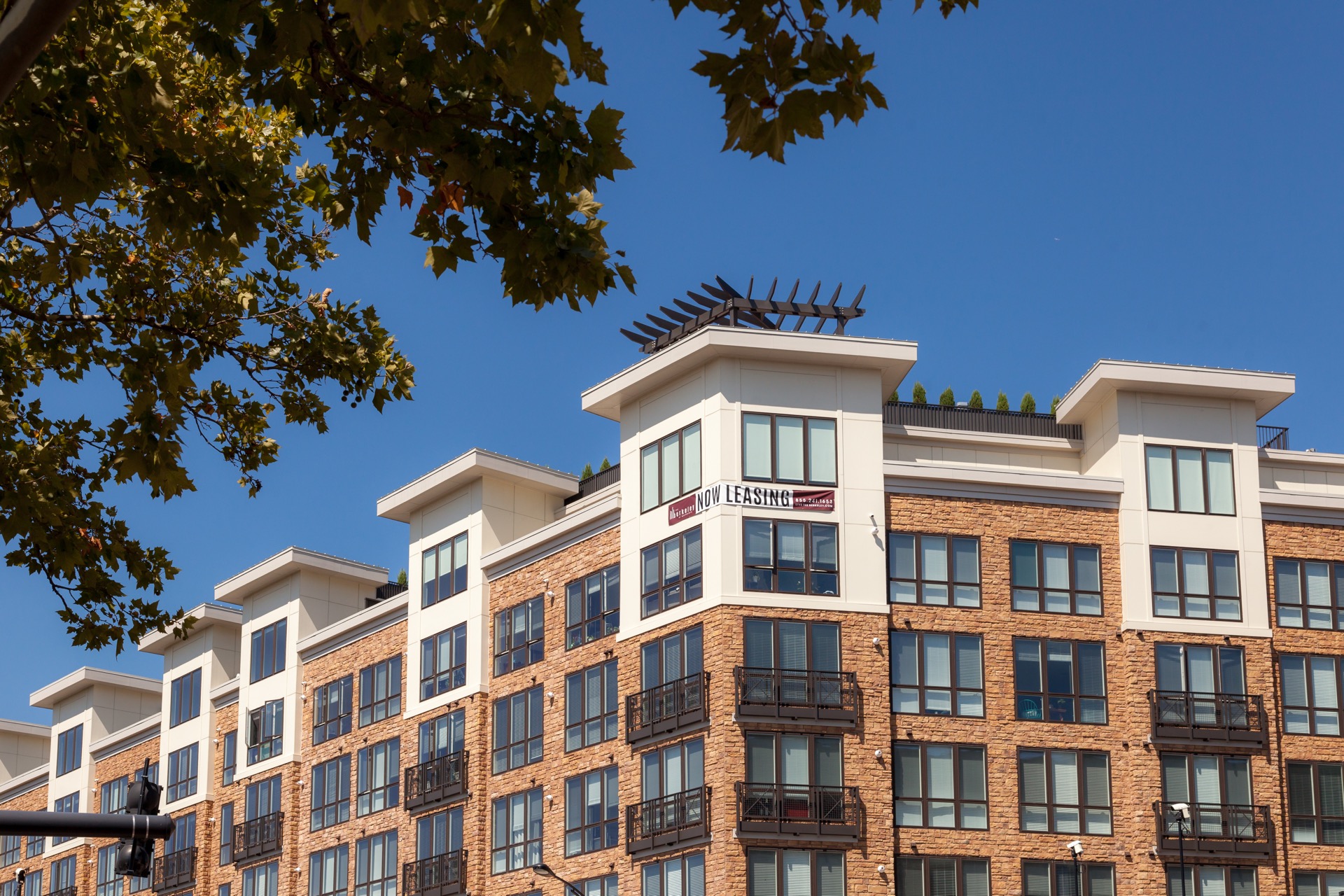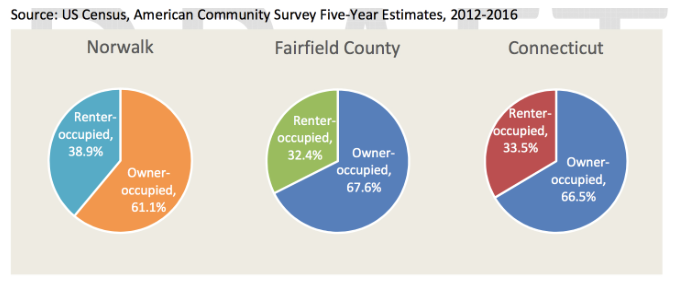Other Planning Efforts
Along with and helping to shape the Wall Street/West Avenue neighborhood, the city is also conducting a Citywide Plan/POCD, a citywide Parking study and a Transit Oriented Development plan around East Avenue.
West Ave/Wall Street Study on Industry
 As part of the study of the Wall Street/West Avenue area, the Connecticut Economic Resource Center (CERC) conducted an analysis of industry trends in the Norwalk region, including both Fairfield and New York counties. The study examined various trends and key characteristics for every industry in the region to determine which industries should be the focus of economic development efforts in the future. The study identified the key industries in Fairfield County that Norwalk should consider supporting based on whether they were mature, growing or industries with potential. A final category included industries that may not have been growing but should be given priority because they are important to the area, nonetheless. Below we consider the industries that were highlighted in the study.
As part of the study of the Wall Street/West Avenue area, the Connecticut Economic Resource Center (CERC) conducted an analysis of industry trends in the Norwalk region, including both Fairfield and New York counties. The study examined various trends and key characteristics for every industry in the region to determine which industries should be the focus of economic development efforts in the future. The study identified the key industries in Fairfield County that Norwalk should consider supporting based on whether they were mature, growing or industries with potential. A final category included industries that may not have been growing but should be given priority because they are important to the area, nonetheless. Below we consider the industries that were highlighted in the study.
Mature Industries with a Strong Fairfield County Presence
Industries in Fairfield County that are considered mature have a strong presence in the County but haven’t seen job growth at the national level over the last seven years. All of these industries have a higher than average effect on the area economy in terms of employment and wages. Therefore, Norwalk should consider strategies to determine what support these industries might need to maintain their presence. Industries in this category include:- Wholesale Electronic Markets and Agents and Brokers
- Publishing Industries (except internet)
- Broadcasting (except internet)
- Telecommunications
Growing Industries with a Strong Fairfield County Presence
Industries identified in this group have both a strong presence in Fairfield County and are growing nationally. The city should have a development strategy to maintain its reputation as an attractive area for these industries to remain or locate in order to take advantage of their continued growth.This category includes the following industries:
- Nonstore Retailers
- Motion Picture and Sound Recording Industries
- Other Information Services
- Amusement, Gambling, and Recreation Industries
Potential Industries
These industries don’t have a strong presence in Fairfield County but are growing nationally and account for a growing proportion of jobs in the region. Because there are a number of workers that commute from Norwalk to Manhattan, the skill set to support these industries most likely exists in Norwalk. Also, the proximity to existing firms and workers may make them viable candidates to attract to the area. Norwalk should research these industries further to determine whether they are a good fit for the city. Potential industries include:- Beverage and Tobacco Product Manufacturing
- Data Processing, Hosting, and Related Services
- Credit Intermediation and Related Activities
- Securities, Commodity Contracts, and Other Financial Investments and Related Activities
- Insurance Carriers and Related Activities Management of Companies and Enterprises
Priority Industries to Retain
A number of industries have previously done well in the region and employed a lot of people but have recently experienced lower than expected growth than would have been expected over a period of time. The city may want to investigate further to understand the reason for low growth and how Norwalk can support these industries. Retention industries include:- Food and Beverage Stores
- Other Information Services
- Professional, Scientific and Technical Services Waste Management and Remediation Services
- Ambulatory Healthcare Services
- Nursing and Residential Care Facilities
- Social Assistance
Housing Profile of Wall St.– West Ave. Neighborhood Shows More Rentals, Older Buildings
 As part of the Wall Street/West Avenue Neighborhood Plan, a study was conducted of Norwalk and surrounding towns of such areas as demographics, housing, industry, and employment conditions. These areas were looked at in light of the goal for the neighborhood: to be an innovative urban environment that is accessible, authentic, lively and affordable. Below are some of findings from the study on Norwalk and the Wall Street-West Avenue area’s.
Norwalk has a larger portion of renter-occupied housing and a smaller portion of owner-occupied units than Fairfield County or Connecticut as a whole. Rental units are in demand as the study shows that vacancy rates are also lower for rentals. One possible reason for this trend (coupled with the higher portion of young, working-age residents that the study also found) is that Norwalkers may be more transient than other people in Fairfield County, or the state overall. Young renters tend to move more frequently than older adults who own their homes. This could present an opportunity for the city to convert these young people into longer-term residents as they get older and start families.
As part of the Wall Street/West Avenue Neighborhood Plan, a study was conducted of Norwalk and surrounding towns of such areas as demographics, housing, industry, and employment conditions. These areas were looked at in light of the goal for the neighborhood: to be an innovative urban environment that is accessible, authentic, lively and affordable. Below are some of findings from the study on Norwalk and the Wall Street-West Avenue area’s.
Norwalk has a larger portion of renter-occupied housing and a smaller portion of owner-occupied units than Fairfield County or Connecticut as a whole. Rental units are in demand as the study shows that vacancy rates are also lower for rentals. One possible reason for this trend (coupled with the higher portion of young, working-age residents that the study also found) is that Norwalkers may be more transient than other people in Fairfield County, or the state overall. Young renters tend to move more frequently than older adults who own their homes. This could present an opportunity for the city to convert these young people into longer-term residents as they get older and start families.
Housing Stock by Occupancy Type, 2016
 A distinct feature of housing in Norwalk is the share of multi-unit housing, which encompasses 51.7% of total housing in the city. Multi-units represent a greater share in Norwalk than the 41.8% and 40% respectively in Fairfield County and Connecticut. This corresponds with the higher rental rates noted above, as multi-unit housing is more likely to be rental units (such as apartment buildings and multi-family homes) than single-family housing.
Norwalk’s housing stock consists primarily of 1-2 bedroom units, 45.1% of housing, compared to Fairfield County (38.7%) and the state of Connecticut (41.7%). This makes sense considering the large share of the population aged 20-34, who may be earlier on in their careers and less able to afford a larger home or selecting renting as a housing preference due to its flexibility. In developments such as Waypointe the latter seems to be the case as many occupants could afford a single family home but are choosing to live in multifamily housing in denser and more urban neighborhoods.
The demographics of Norwalk are also reflected in data regarding when the householder moved into their current home. A larger percentage of Norwalk residents (35.7%) have moved into their home between 2010 and 2016 compared to Fairfield County and Connecticut with rates of 32.5% and 31.9% respectively. Younger adults are more likely to move into their current home recently as that age group relocates more as they finish college, obtain jobs, and start families. This is also consistent with the rental occupancy rates in Norwalk, as renters are more easily able to move than homeowners
A distinct feature of housing in Norwalk is the share of multi-unit housing, which encompasses 51.7% of total housing in the city. Multi-units represent a greater share in Norwalk than the 41.8% and 40% respectively in Fairfield County and Connecticut. This corresponds with the higher rental rates noted above, as multi-unit housing is more likely to be rental units (such as apartment buildings and multi-family homes) than single-family housing.
Norwalk’s housing stock consists primarily of 1-2 bedroom units, 45.1% of housing, compared to Fairfield County (38.7%) and the state of Connecticut (41.7%). This makes sense considering the large share of the population aged 20-34, who may be earlier on in their careers and less able to afford a larger home or selecting renting as a housing preference due to its flexibility. In developments such as Waypointe the latter seems to be the case as many occupants could afford a single family home but are choosing to live in multifamily housing in denser and more urban neighborhoods.
The demographics of Norwalk are also reflected in data regarding when the householder moved into their current home. A larger percentage of Norwalk residents (35.7%) have moved into their home between 2010 and 2016 compared to Fairfield County and Connecticut with rates of 32.5% and 31.9% respectively. Younger adults are more likely to move into their current home recently as that age group relocates more as they finish college, obtain jobs, and start families. This is also consistent with the rental occupancy rates in Norwalk, as renters are more easily able to move than homeowners
Pricing
Another distinction of the housing market in Fairfield County relative to Connecticut is housing prices. Housing that is occupied by the owner tends to be much more expensive in the county and in Norwalk compared to the state overall. Both Norwalk and Fairfield County have a much smaller portion of owner-occupied housing units valued below $300,000 than does the state overall.Value of Owner-Occupied Units, 2016
 Low ownership rates along with high rental rates could also be indicative of tight housing stock or lack of options for prospective purchasers. It’s interesting to note that in the stakeholder outreach sessions held during the development of the Wall Street-West Ave Neighborhood Plan, many residents said that rents are too high; businesses also indicated that many employees don’t live nearby because they can’t afford to. Renters also wanted to purchase homes in the area, but said they couldn’t because of high housing costs.
Low ownership rates along with high rental rates could also be indicative of tight housing stock or lack of options for prospective purchasers. It’s interesting to note that in the stakeholder outreach sessions held during the development of the Wall Street-West Ave Neighborhood Plan, many residents said that rents are too high; businesses also indicated that many employees don’t live nearby because they can’t afford to. Renters also wanted to purchase homes in the area, but said they couldn’t because of high housing costs.
Future Housing Demand
When looking at the future of housing in Norwalk, the study looked at a number of factors including growth in the adult population and shifts in the age distribution. According to EMSI, the population of Norwalk is expected to increase by 3,700 over the next 10 years. The overall change in the number of projected households for Norwalk through 2028 is an increase of over 1,800 households, most of this growth will be in households with a head of household that is under 35 years old and those aged 65 and older. These population and demographic changes means that more housing and more variety of housing will be needed. The findings suggest the need to consider additional housing options such as micro-units or studio apartments, which could be more accessible financially to younger workers or those of retirement age. Considering the future needs of these groups, housing that will attract young professionals permanently to the area as well as more reasonably priced housing options for working families will be important for the future. The potential new developments in Norwalk will most likely increase the population in Norwalk and in turn increase the demand for additional units and more housing variety throughout Norwalk’s neighborhoods. This additional housing stock and options would help dispel concerns that housing is currently too expensive in Norwalk. Read the Full Draft of the Wall Street/West Avenue Neighborhood PlanTimeline: Redevelopment
Other Planning Efforts
Along with and helping to shape the Wall Street/West Avenue and Washington Street/South Main neighborhoods, the city is also conducting a Citywide Plan/POCD as well as a citywide Parking study.
Have A Say: You Live, Work & Visit Here!
We need everyone who lives, works and visits these neighborhoods to have a say. If you are one of the following, we would like to hear from you:
- Resident
- Property owner
- Business owner
- Public official
- Institutional agency
- Visitor
Help us to capture the true, current temperature of the Wall Street/West Avenue and Washington Street/South Main neighborhoods and make your mark on Norwalk's future.
If you have any questions about the Redevelopment planning efforts, contact Tami Strauss at tstrauss@norwalkct.org or call 203-854-7810 x46787




